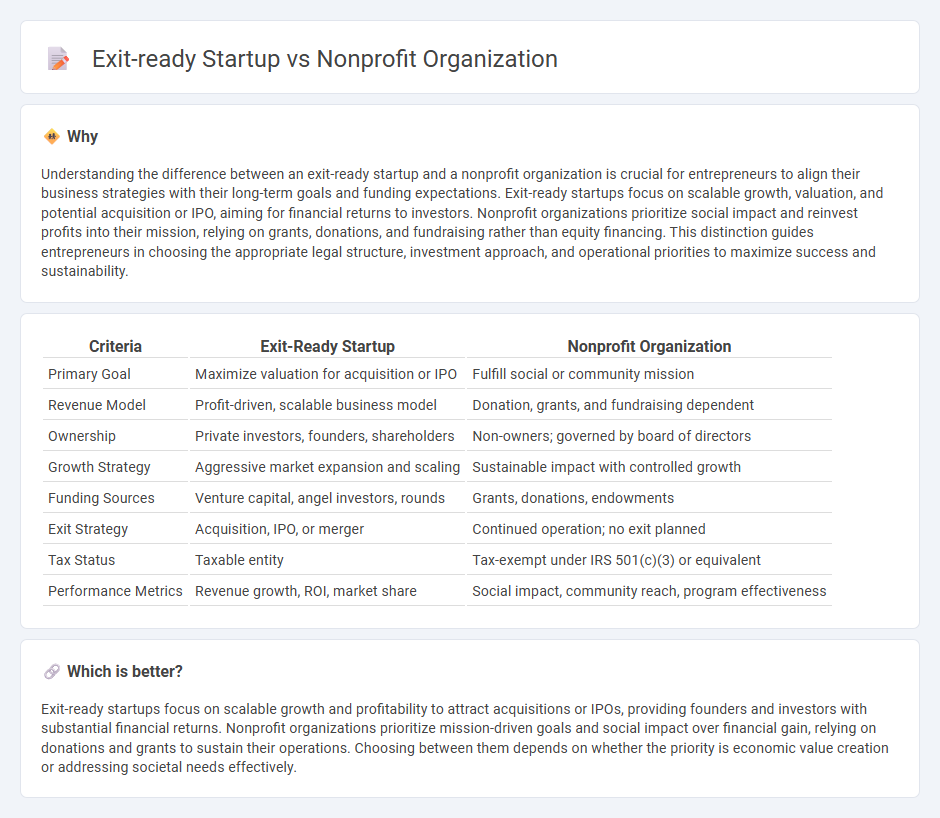
Exit-ready startups focus on rapid growth and scalability with the goal of an eventual acquisition or public offering, generating substantial financial returns for investors. Nonprofit organizations prioritize mission-driven objectives, reinvesting surplus revenues into programs and services to serve the public good without the intention of profit distribution. Explore the key differences and strategic considerations between these two entrepreneurial models to understand which aligns best with your goals.
Why it is important
Understanding the difference between an exit-ready startup and a nonprofit organization is crucial for entrepreneurs to align their business strategies with their long-term goals and funding expectations. Exit-ready startups focus on scalable growth, valuation, and potential acquisition or IPO, aiming for financial returns to investors. Nonprofit organizations prioritize social impact and reinvest profits into their mission, relying on grants, donations, and fundraising rather than equity financing. This distinction guides entrepreneurs in choosing the appropriate legal structure, investment approach, and operational priorities to maximize success and sustainability.
Comparison Table
| Criteria | Exit-Ready Startup | Nonprofit Organization |
|---|---|---|
| Primary Goal | Maximize valuation for acquisition or IPO | Fulfill social or community mission |
| Revenue Model | Profit-driven, scalable business model | Donation, grants, and fundraising dependent |
| Ownership | Private investors, founders, shareholders | Non-owners; governed by board of directors |
| Growth Strategy | Aggressive market expansion and scaling | Sustainable impact with controlled growth |
| Funding Sources | Venture capital, angel investors, rounds | Grants, donations, endowments |
| Exit Strategy | Acquisition, IPO, or merger | Continued operation; no exit planned |
| Tax Status | Taxable entity | Tax-exempt under IRS 501(c)(3) or equivalent |
| Performance Metrics | Revenue growth, ROI, market share | Social impact, community reach, program effectiveness |
Which is better?
Exit-ready startups focus on scalable growth and profitability to attract acquisitions or IPOs, providing founders and investors with substantial financial returns. Nonprofit organizations prioritize mission-driven goals and social impact over financial gain, relying on donations and grants to sustain their operations. Choosing between them depends on whether the priority is economic value creation or addressing societal needs effectively.
Connection
Exit-ready startups and nonprofit organizations both emphasize strategic planning and sustainable impact, focusing on long-term goals rather than immediate profits. These entities prioritize scalable models and measurable outcomes to attract funding and support from investors or donors. Effective leadership and adaptive business strategies enable exit-ready startups to transition ownership or merge, while nonprofits seek to amplify mission-driven success through partnerships or endowments.
Key Terms
Mission-driven
Nonprofit organizations prioritize social impact and mission-driven goals, reinvesting all revenue into programs that serve their cause rather than distributing profits to shareholders. Exit-ready startups emphasize rapid growth and market scalability with a clear strategy for acquisition or public offering to maximize investor returns. Explore detailed insights on aligning organizational focus with your strategic goals.
Scalability
Nonprofit organizations prioritize sustainable impact over rapid growth, often relying on grant funding and donations to support scalable programs addressing social issues. Exit-ready startups emphasize aggressive scalability through innovative products and venture capital investment, targeting exponential revenue growth and market expansion to attract acquisition or IPO opportunities. Explore the key differences in scalability strategies between nonprofits and exit-ready startups to understand their unique growth models.
Exit strategy
Nonprofit organizations prioritize mission-driven goals and reinvest all surplus funds into their social causes, foregoing traditional exit strategies that generate financial returns. In contrast, exit-ready startups design scalable business models aimed at mergers, acquisitions, or initial public offerings (IPOs) to maximize investor returns and market impact. Explore strategies to align your organization's goals with the optimal growth and exit approach.
Source and External Links
What Is A Nonprofit? The Different Types of Nonprofits & How To Start - A nonprofit organization is a business given tax-exempt status by the IRS because it furthers religious, scientific, charitable, educational, literary, or public safety purposes and operates not to make a profit but to advance a social cause or shared mission.
Nonprofit organization - Wikipedia - A nonprofit organization is a non-governmental legal entity operating for social benefit, not profit distribution, accountable to donors and the public, distinct from not-for-profit organizations which may serve members rather than the general public.
non-profit organizations | Wex - Law.Cornell.Edu - Nonprofit organizations are groups organized to serve purposes other than generating profit, with no income distributed to members or directors, and they include entities like charities, churches, schools, hospitals, and political organizations governed primarily by state law.
 dowidth.com
dowidth.com